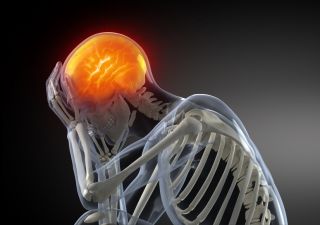Many of us hold our breath unintentionally while engaged in daily tasks such as reading and writing email (a phenomenon called “email apnea” or “screen apnea” [1]). We simply “forget” to breathe. This deficit of oxygen-flow to the brain can result in headaches, increased stress, loss of concentration, and fatigue. Yet simple breathing exercises can restore normal, healthy breathing, promote a healthier brain, and even foster more positive mindsets and perspectives. Here’s what your brain looks like on oxygen, along with a simple breathing exercise you can practice each day.
Conscious and unconscious breathing are controlled by two different processes in the brain. The first kind of breathing - involuntary and ongoing - is called metabolic breathing and is managed by “deep” parts of the brain, pertaining to early stages of human evolution: the brainstem, the hypothalamus, and the limbic system. The other kind of voluntary, conscious breathing is controlled by parts of the brain’s cortex that are much more recent in human evolution. Simple conscious acts of breathing can therefore bridge between involuntary and conscious function - both in the brain and in the body.

Conscious breathing can also support emotional health, and affect our mindsets and perspectives. In 2007, brain scientists in the Bender Institute for Neuroimaging in Germany compared meditators to non-meditators performing a breathing exercise. They found that in both groups engaged- breathing resulted in increased activity in the rostral Anterior Cingulate Cortex (rACC) – a brain region that is tied to the ability to regulate one’s emotions. The rACC has particularly been shown to be strongly involved in the efficacy of cognitive Behavior Therapy for treating depression and Post-Traumatic Stress Disorder [3].
So – what can you do to “breathe right”? In the past few decades, scientists have studied various types of breathing exercises, many of which originate from the ancient yoga practices of Pranayama, practiced by millions of people over thousands of years. Pranayama exercises have been used to reduce the anxiety and posttraumatic symptoms related to mass disasters like 9/11, Hurricane Katrina, and the 2004 Southeast Asian Tsunami [4] and have been shown to affect multiple parts of the brain, including: the release of oxytocin and activation of pleasure and motivation neural centers.
A simple Pranayama exercise you can use any time throughout the day to restore oxygen flow to your brain is Sama Vritti or “equal breathing”. Here are the instructions. Give it a try and share your experience.
Did it make a difference?
- Sit comfortably with your back upright and loosen the palms of your hands in your lap or on your knees.
- Close your eyes and simply notice your breath, without trying to control it in any way
- Now, start counting from 1 to 4 as you inhale, and the same as you exhale. This way breathing in and breathing out takes the same amount of time
- As you start to breathe more deeply, increase the number you count to
- Continue to breathe this way until you synchronize on the new rhythm of breathing, and you feel that your breathe has slowed down and has become deeper
[1] Rheingold, “Net Smart: How to thrive Online,” the MIT Press, 2012
[2] Hölzel et al. (2007) “Differential engagement of anterior cingulated and adjacent medial frontal cortex in adept meditators and non-meditators” Neuroscience Letters, 421(1), 16–21.
[3] Taylor and Liberson ,"Neural correlates of emotion regulation in psychopathology," Trends in Cognitive Sciences, Volume 11, Issue 10, October 2007, 413–418
[4] Gerbarg & Brown ,”Yoga: a breath of relief for hurricane Katrina refugees,” Current Psychiatry, Vol. 4, No, 10, October 2005


